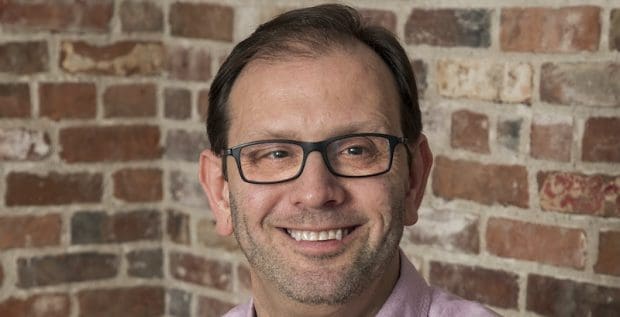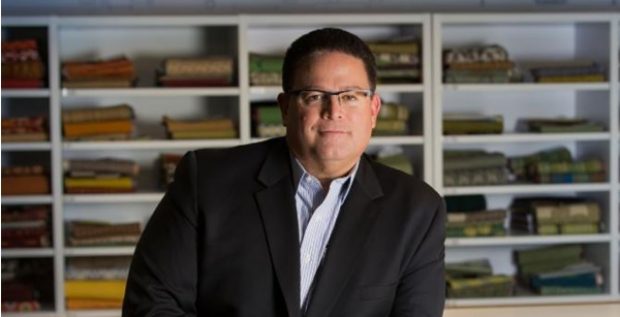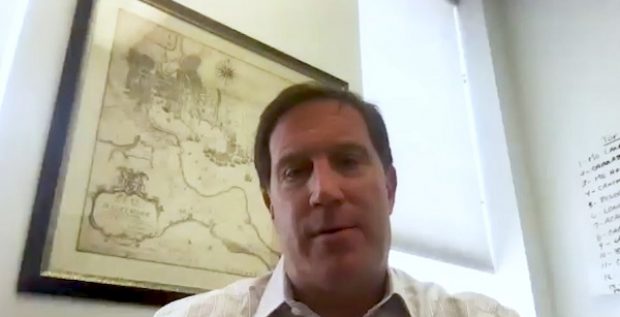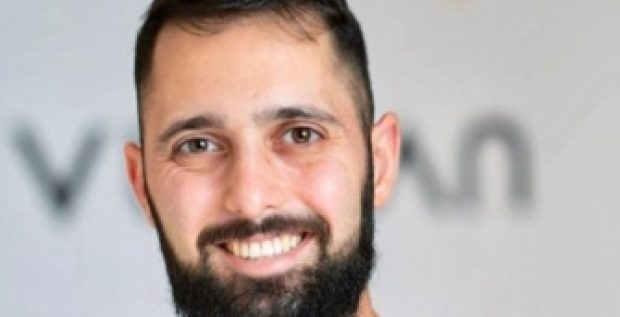Bryan Tracy is the CEO and co-founder of White Dog Labs as well as board chair of the Delaware Sustainable Chemistry Alliance (DESCA). Based in New Castle, Delware, White Dog Labs is a biotechnology company that has pioneered an innovative new class of fermentation procedures that sustainably and renewably convert carbohydrates and gas into almost any biochemical. Several months ago, the company earned a grant from the Department of Energy, and has used this grant to develop its proprietary MixoFerm™ technology. Meanwhile, at DESCA, Bryan applies his expertise in business and chemistry to foster cooperation between members of the public and private sectors making critical scientific discoveries in the Delaware region.
EDWIN WARFIELD: Tell us about your history as a chemist and entrepreneur.
BRYAN TRACY: The first company I started was back in 2009. That was out of my Ph.D. studies out of the University of Delaware and Northwestern University. It was founded on the concept of creating new, bio-based technologies to create sustainable chemicals, and ideally sustainable fuels. We were to some extent playing God on bacteria, making new bacteria to do fancy beer fermentations. Those fancy beer fermentations would make the exact same products that the petrochemical industry makes.
[My company] Elcriton was fortunate to be able to license its earlier stage technologies into China, as China was actually taking one of the lead positions in making chemicals through these new approaches and not having necessarily the incumbent technology to compete against. Then, subsequently, we expanded our business as well into Europe, largely into Germany, working with several major chemical companies there. Instead of just using sugars, which our technology uses, we also started using waste gases. So we could take the off–gas from a steel mill production facility or even from electricity generation facility, off of a natural gas burning electricity generation facility, and consume that with our microorganisms.
Along the way, Elcriton became sort of a lifestyle business, answering the needs of big companies from contract services and so forth and then licensing technologies here and there. We attracted the attention, then, of some investors out at Silicon Valley: a group called Musea Ventures, which is actually the family wealth of the Somekh family, particularly Sass Somekh—who I’ll describe in just a little bit—but through that we actually co-founded the second company called White Dog Labs.
White Dog Labs was looking at a distinctly different technology. We had the microorganisms to actually produce biochemicals through fancy fermentations, but there’s another big challenge: How do I pull those biochemicals out of the fermentation broths, out of that liquid solution itself, in an efficient fashion? So, White Dog created several technologies in that space and then eventually White Dog had a bigger appetite and subsequently acquired Elcriton back in 2014.
The merging of the two technologies now has given rise to the focus of White Dog to create full technology packages to convert sugars, gases, agricultural wastes, and so forth into commodity-scale chemical, specialty chemical, and also protein for animal feed—to help feed the rest of the world.
Q. Can you describe the technology in detail? How do you go about converting these substances into the desired chemicals?
A. White Dog has a technology that we call MixoFerm™. In the world of biochemicals, it’s called “bio” because most often your input to the process is a biological input, like sugar from corn or waste sugar from switchgrass or something of that sort. That input is very different from oil, and yet you want to make the exact same products that you’re making from oil. So, we would argue that that input of sugar is quite incompatible to make the same oil products.
In the meantime, you can add natural gas for example into our fermentation process to simultaneously consume these energy-rich gases with sugars, so we mix the best of both worlds. We “MixoFerm” fossil inputs and bio inputs together to give the most cost-effective outputs and very sustainable outputs to produce chemicals.
You have to have the understanding that sustainability has three pillars. It’s not just being more environmentally friendly and being more socially friendly but also has to be economically competitive. That’s where we’re able to mix the best of all those worlds and meet good economics to compete with fossil-based products, particularly given the fact that oil these days, we believe long-term, is going to be relatively low price around $50 a barrel, so we have to be able to compete on those economics, and MixoFerm allows us to that.
Q. Where does a customer see value in this technology?
A. Where the customers derive value from our technology is really two places. The first one is competition on the economics. Now, since we are able to use multiple feed stocks we actually suggest—and we can show economically—that we can hedge variations, and maybe one day your sugar cost is more expensive versus your natural gas cost is cheaper, and vice versa. So, if you’re using both and you’re not simply dependent upon one of them we are able to hedge the economics of the process. That’s value to our customers and the consumers of our products.
Subsequently, in addition to that, we still have a large bio component going into our product, and that bio component has a significantly reduced CO2 footprint associated with it. We are reducing the amount of greenhouse gas emissions through the production of the process. Now, there’s been lots of controversy or frustration with this. There aren’t many who pay premiums for green products; however, if your building’s LEED-certified or if you can claim a large bio content in paints or in your consumer products—the plant bottle for example that saved Dasani Water: Dasani Water was losing a tremendous amount of market share, and it recaptured its market share because now it’s making the plant-based bottle. You don’t pay anymore for that bottle, but it’s the tiebreaker. If something’s more sustainable, it’s the tiebreaker versus the less sustainable product if you can compete on economics. So that’s the other part of the value that we bring to our customers: a reduced CO2 emissions footprint and a bio component to it for when they make their consumer product, such as our first product, which is acetone. When we make the acetone, that acetone is subsequently used for the production of artificial glass—methyl methacrylate or Plexiglas. So now, that Plexiglas is more sustainable and our customers get the value of that.
Q. Tell us about your co-founders, Sass and Talli Somekh.
A. Sass and his son, Talli created their venture fund called Musea Ventures with the drive to do both good and well. They ideally want to do well financially with their investments, while at the same time doing good for society. It’s a family office, so they have the ability to see a longer term through their investment and to take different risks than just a traditional Venture Capital (VC) fund would.
Sass Somekh himself was an incredibly successful semiconductor executive. He was one of three gentleman that really revamped the product lines for a company called Applied Materials back in the 80s. That eventually led to Applied Materials transitioning from being about a $50 million a year company to a multi-billion dollar company, because they became the dominant producer of equipment to make the semiconductor chips. In fact, one of the product lines that Sass is most proud of—rightly so—still is part of the process to make every single semiconductor chip today—every single one. And that piece of equipment is in the permanent collection in the Smithsonian. So, he was fortunate enough to ride a very successful financial wave as well in the semiconductor industry. For that, he’s in the Silicon Valley Hall of Fame. He has won one of the semi lifetime achievement awards—a very illustrious career.
Now, he retired from the semiconductor industry back in 2008 and with his son, Talli, they started placing small investments into companies that, again, do both good and well. They mixed up their portfolio but White Dog Labs is actually their largest investment to date, to the tune of nearly $10 million, because we’re technology that really has the potential to be financially very successful—even with just our first plant—but at the same time it will be a disruptive technology that changes the perspective on how you can make fuels, chemicals, speciality products, and protein to feed the world. Sass is the executive chairman of our company—very, very involved in the company. He’s been a very significant mentor to me personally. He and I get to travel the world, interacting with clients as we build the company and as we look for financing for our first plant—and that’s the stage, by the way, where we are with our company: hoping to close on the financing for our first bio-acetone plant, which we will like to construct and have operating in the year 2020.
Q. What are the next steps as you scale the company?
A. White Dog Labs’ major commercial aspiration right now—our first—is a 75,000 ton per year bio-acetone plant. That’s 25 million gallons. We’re looking to site that either in South Dakota or Minnesota. The reason being we would consume upwards of 10 millions bushels of corn per year, so we need to be somewhere where corn is available and corn is affordable. That plant—we’re looking to finance it. We’re actually in the part II submission process for a Department of Energy (DOE) loan. The Department of Energy actually has about $5 billion set aside for loans, up to 75% loans, at low interest rates, to build such renewable biochemical or renewable plants. We obviously have to raise the rest of the 25% of the financing for the plant. We intend on doing that in terms of equity, as opposed to debt. That’s a 10-year pack back period to the DOE, so your economics have to be sufficient to justify that: have a high enough debt service to coverage ratio. We’re in the process right now of concluding on our demonstration to show enough run time at sufficiently large scale to provide the DOE with enough comfort to say, “yes, the technology will be able to get to full production scale and will not be a potential black eye on the DOE for making a commitment to such a plant.”
Q. What makes Delaware the right place to do this work?
A. First of all, I started my first company Elcriton, out of essentially finishing up my Ph.D studies at University of Delaware. That’s where we got our roots, but we have not left because the human capital in the chemical industry and in the materials industry is second to none in the Delaware region compared to anywhere else in the world. In fact, 30% of the chemical industry is employed in about a 100-mile radius of Wilmington, Delaware. It rivals that of Houston and Chicago. So, getting access to industry knowledge for connections to decision-makers within large companies, to get assistance on IP strategy, to get assistance on technology development and so forth—it’s literally maybe a neighborhood away from you in Delaware, to find a world class expert in that space.
Unfortunately, the current Dow–DuPont merger has released a tremendous amount of DuPont workforce back into the open market, which is probably one of those natural lifecycles of companies growing and seeing their twilight and so forth. But for us, we’ve been able to access that recently-left DuPont talent to assist us and that saved us tremendous amounts of money on navigating the technology and the business landscape for our products that we explore. And additionally, the cost of living, the cost of business—particularly in Delaware—is very, very good. I make a joke about it, but we have had no challenge in attracting young, thirsty, bright-eyed—for example, Ph.D. scientists out of the Bay area, the San Francisco area; or Boston; or San Diego—because as they lay down the roots and want to have families and so forth, for them $2,700 a month in Mountain View, California, when you’re competing against Google engineers, gets you a one bedroom apartment. In Delaware, you can get a starter castle down in Middletown, Delaware and plant your roots and be able to support your family with no challenges whatsoever on the same types of salaries that we pay them. That’s one of the advantages of Delaware.
Lastly, in terms of Delaware, it has a world-class research institute—that being University of Delaware. That is actually a pretty untapped resource to date. They’re not well known for technology transfer and for developing entrepreneurial students and so forth. We’re at the forefront of taking advantage of that capability and cultivating that being a part of that ecosystem.
Q. Where do you see White Dog Labs in five years?
A. White Dog Labs in five years has probably got one of two fates. The first one is on the back side of a successful acetone plant, we hope that the IPO markets for our types of companies improve, and so subsequent plants will be financed through a successful initial public offering, as we go public. Or, particularly if a couple of our other products that we are working on—namely protein-based products—they are very ripe for a strategic acquisition, so I think it’s very likely that we will be at the later terms of a joint development relationship with a major corn processor for example, or ethanol producer, or chemical company, en route to an acquisition of the company.
We have plenty of time to get there—five years to get there—and many challenges to overcome, but we see the future for White Dog being very, very bright with the diversity of products that we have, the competitive advantages that we have with our technology, and the sheer fact that we are addressing not just real, critical needs within the world and our society, but ones in which we are creating tremendous value in the markets. So, our customers capitalize and profit off of what we are able to develop.
Q. Will your technology play a role in stopping future food shortages around the world?
A. How well can our technology disrupt the protein industry to make food for mankind? And that’s a real critical issue that we have coming up. It’s a fact. We’re en route to being a population of 9 billion people by 2050. Now, that’s a scary number, but the more significant number is the fact that we will at least double—potentially triple—the amount of first-world population by 2050 as well. And that’s the consuming population. That’s the population that’s no longer going to be largely just plant-based protein-consuming and so forth. Rather, they’re going to start eating more beef, more poultry, more fish, and more pork. But from a cultural perspective, there’s no hesitation to eat fish and poultry.
So, the aquaculture industry, in fact, now on a mass basis of food production—protein being produced, meat being produced from the aquaculture industry—outweighs the world beef industry. Also, though—unfortunately—fish, for the large part, only eat other fish. And we have to supplement their diet; otherwise we will out-fish the ocean of sardines and bait fish. We have to create another solution to feed these fish that’s not going to jeopardize the health of our oceans. So, we have a unique opportunity to create a bacteria protein—what we call single-cell protein—in order to create a new protein source that the fish find very palatable, that they’ll eat and grow off of. That is a market that’s growing in leaps and bounds, and one which cannot be addressed by any fossil fuel based technology.
Q. With all these large-scale issues, what causes personally motivate you?
A. Outside of White Dog Labs, and Elcriton in the past, there are two causes that I’m very passionate about. The first is to assist other entrepreneurs, particularly in this space because it’s a space that I know relatively well, to take the risk to create their own companies and to make new technologies that can change the face of the world. With that, I serve as the board chair of an organization called the Delaware Sustainable Chemistry Alliance. It’s a mouthful—we call ourselves DESCA for short—and it’s essentially tapped into what I like to call the “domain expertise” or the “brain trust” in the chemical and material industry that our region has, to connect them, and to get that very venerable, experienced brain trust—that’s a nice way of saying early retirees or retirees—to interact with the younger entrepreneurs to sharpen their understanding of the market and the technology applications so they refine their technology to something that’s got a nearer-term commercial win. DESCA does exactly that. We create venues and opportunities for entrepreneurs and the domain experts to interact, to create new, young, early stage companies in these types of spaces. I’m very proud of that organization and we’re doing a great job so far, and I hope to see five or six new White Dog Labs-type of companies in the next three or four years in Delaware because of that.
Secondly, I’m incredibly committed to STEM education: science, technology, engineering, and mathematics. I’m very fortunate to be the board chair of an organization called FAME—that’s the Forum to Advance Minorities in Engineering. And that is an organization over the past 40 years; we’ll have our 40th year anniversary this year. We provide up to 270 hours per year of outside-school curriculum in science and engineering and mathematics to women, to African-Americans, to Latinos, to underrepresented populations in STEM disciplines. We serve a core population of about 270 students per year, and we’ve expanded our program to what we call “Stimulated Change.” We’re now serving a higher-needs population: students who are from communities that don’t get the resources that I grew up with. So, from 4th to 7th grade, we provide them about 50–70 hours of outside school curriculum to get them exposed to STEM education through a really unique process. That program alone, in a state the size of Delaware, we were able to impact 1500 students with a very efficient, small non-profit organization called FAME that collaborates with a number of others.
You know, growing up in a middle-class type of family, as an Army brat, I was afforded plenty of opportunity to go to good schools, and to try to reach my full talent and full development capability, but there’s such a huge population there that’s not given that. From a strange engineering perspective, I look at it also—as a society and as a country, we are not tapping into the potential of at least 50% of our population: that’s minorities and women in terms of the STEM discipline. How great could we be as a society if we tapped into that additional 50% and allow them to reach their full potential? Taking away demographics and those types of stories, just from that perspective of benefitting all of our society and making the cliché statement today—”making America greater”—I think activities such as FAME are going to be some of the greatest lasting impact that I can personally have.
Q. What do you do when you’re not working?
A. I used to do a lot of running, but then I became a dad, and so I actually spend the majority of my time now trying to get out in the jogger with my daughter. But my wife and I try and stay active, hiking around and doing our nonprofit activities inside the community. We also get on the Chesapeake Bay quite a bit. We have a boat that we like to essentially unplug from the rest of the society and get down to deeper waters and just ignore everything. We do that as much as we possibly can, and we have about a month and a half left until we have to button it up for the season.
Q. What kinds of challenges does White Dog Labs face?
A. We’re competing against the world’s biggest commodities. How do we succeed in that world? You have to make sure you have a differentiated technology that brings value to the consumer so they’re not paying for it based upon some governmental incentive or some false advertising. That’s challenge number one that we’ve had to—and we continue to—struggle with.
The second one is getting access to decision-makers in 50–70 thousand person companies. There’s not a magical telephone that you call up and say, “Hey, this is the greatest opportunity in the world, jump on this and let’s do this.” You have to navigate tremendous bureaucracy or hierarchy, and that’s where we failed miserably earlier on, but subsequently through DESCA we’ve been able to make the right connections and get much better with that.
Q. How do you see yourself as an entrepreneur?
A. As an entrepreneur you get to evaluate yourself frequently. My strengths are I am pretty flexible and I can improvise and ad hoc and pivot pretty well. And as a small company, you’re constantly doing that. My weaknesses: I can be kind of headstrong. We started hiring more experienced individuals in specific spaces that have a tremendous amount of experience compared to me in this specific technology. So, being able to give them the leeway and say, “I fully trust you,” or having a new type of relationship whereby I listen fully to them—that’s been a weakness that I’ve struggled with.
Q. What’s next for you individually after White Dog Labs?
A. Opportunities for me individually: more expansion of the company—we are sitting on a platform technology that can do quite a few things. So the opportunity for me individually is to actually start more companies and expand into new spaces.
Q. Are there threats to company’s continued success?
A. Threats for the company—we have a lot. The biggest threat for the company is, again, oil going down to $30 a barrel. That makes everything more challenging. We are a unique company where we can compete at $50 per barrel of oil, but with the recent dynamics in OPEC and all the advancements in fracking technology, it has essentially come to a point where OPEC has taken their stand—they will not be the swing producer; the US is now the swing producer. So, the question is “How much does it cost to produce oil in the US?” If fracking technology gets much, much better, that could bring down the cost of oil truly down to, again, $35 a barrel. That’s a big threat to us—if we only tag ourselves to petroleum-based products, which is why we go into proteins because there is no competition from oil for proteins.
Additional threats: we actually do not live and die by government incentives. In fact, we would shy away from anything where government incentive is needed because this is an artificial market and we would much rather compete in an open, free market. Really, it’s the cost of oil that’s the real big challenge.
Q. You mentioned the Dow–DuPont merger earlier. How has the merger affected your industry as a whole?
A. More than just releasing individuals to provide a lot more human capital in this space, other opportunities that are going to occur—which I hope will occur—we would like for more early stage companies to be created in our region. It builds the community bigger and bigger and bigger, which brings in more capital—more human capital—and more focus on our region, to say, “hey, this is an exciting area,” and it changes the ecosystem as a whole. We’re at the forefront of that, so we would like to see more of that. There’s going to be more opportunity like that.
However, at the same time that Dow-DuPont merger, particularly for Delaware—and I do have a penchant and an interest in Delaware; I do care about the community significantly. DuPont has been the innovation hub for the entire state of Delaware, period, for the past 120 years. It has been the innovation center. The merger of the two companies essentially is reducing inefficiencies in research and development. Big companies no longer own research and development. Pharma’s done this a long time ago, moving away from this. Chemical companies are doing it right now. The reason being their investment into a small business is five times more efficient than into their own internal R&D, where the incentives are completely different, there’s bureaucracy, and there’s a lot more challenges to getting effective research done. So, big companies do not own it. They’re putting that money out into small businesses instead.
In the past, DuPont, if they had technology internal that they were not interested in cultivating because it addressed only a $50 million market, or it was too far away from their core business, an entrepreneurial employee could take a license to the technology, step out of the company, and go after it for themselves. And you can draw a direct line to probably 70% of all of the enterprise businesses in Delaware over the past 70–100 years—one direct line to how they’re connected to DuPont. Either it was direct technology taken out of DuPont, or DuPont was their first biggest customer that allowed them to survive in the first place. That’s gone. I don’t mean to paint a really sobering picture, but that innovation center is gone from Delaware. There’s a huge vacuum and I don’t know what fills it quite yet, and that’s going to be a big challenge for the State of Delaware moving forward: How do we fill that and how do we continue with the legacy successes and innovation that came out of DuPont in the past?
The innovation spans incredible lengths. Cephalon came out of DuPont. Endo Pharmaceuticals came out of DuPont. WL Gore came out of DuPont. US Airways came out of DuPont—that was Allegheny Airlines, which was essentially to service flights from Pittsburgh to Philadelphia for DuPont employees. I mean, the tremendous amount of impact and economic influence in just broad implant economic growth that that had, I really fear, is a thing of the past.
Q. So, why is the company named “White Dog Labs”?
A. I often get asked the question: “What is White Dog? Where does that name come from?” It leads to a lot of confusion. We are not a designer puppy mill, thank goodness, but rather the name gets it genesis from the fact that that’s virgin distillates from corn grain alcohol before you cask it to make bourbon and whisky. Our company creates new technologies to essentially create new alcohols, and some of our founders of the company have a certain affinity for bourbons and whiskies, so we decided: “Why not name the company White Dog?” So, we’re now White Dog Labs and maybe down the road we’ll also dabble in the actual human consuming spirits—we shall see. But in the meantime I do not suggest humans consuming our products directly.



















